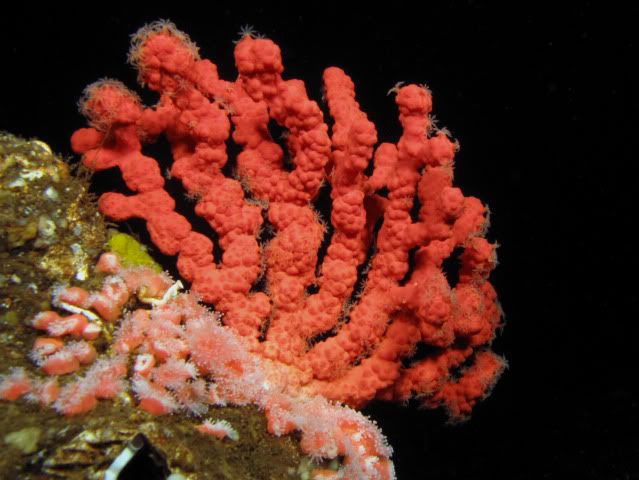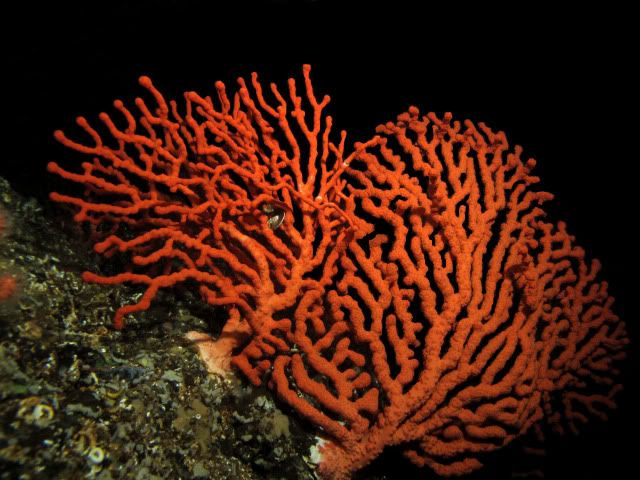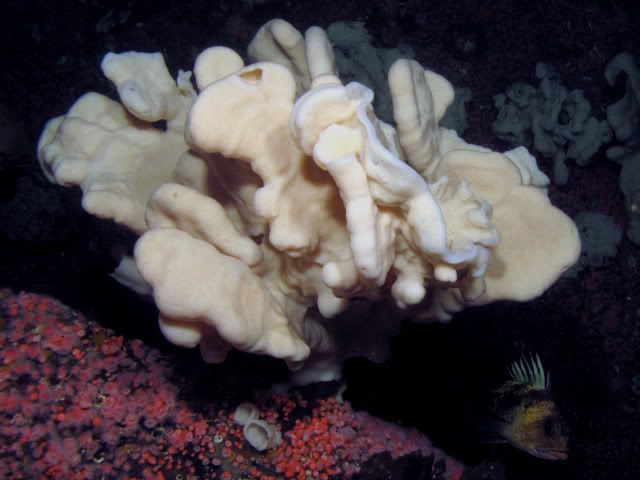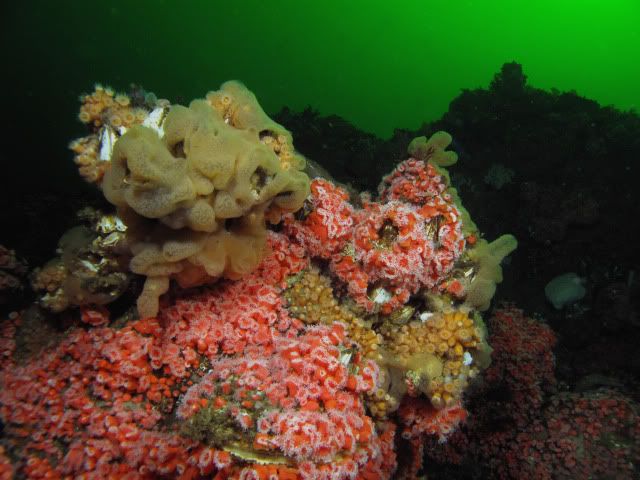One of my motivations for learning how to tech dive was so that I could go see the deep water gorgonians found only at certain current-swept locations along the Sunshine Coast and Vancouver Island, British Columbia. This past October I finally got that opportunity, when I joined a group of friends and fellow photographers accompanying Curt Bowen, of Advanced Diver Magazine, to Nootka Sound. My dive buddy Valerie and I had planned a 180-foot dive, which would put us along the top of the wall that bottomed out in a channel at about 210. We'd been told that the gorgonians started at about 150, and by 180 feet we'd be seeing some of the larger ones. The channel has been described to me as a coral forest ... but we'd decided to keep our initial plan conservative. We each brought with us doubles with 21/35, and deco bottles with EAN50 and O2.
The day before our planned dive, Valerie received a phone call ... her mom had suffered a heart attack and passed away ... she had to leave. This put me in decision mode ... bag the dive, or alter my plans. Curt and his chief editor, John Rawlings were planning to head down to the channel at about 210. Seattle photographer Bruce Yates was planning a recreational dive to the cloud sponges, at depths less than 100 fsw. I either go with Bruce or go alone. Bruce, being a typical photographer, preferred solo. So I decided to go it alone.
As a precaution I put some backgas in an AL40 for bailout. And thinking about the potential for strong current, decided to limit the number of bottles I was going to sling ... considering that I had reef to follow all the way to the surface I decided to go with EAN50 and leave the O2 on the boat. That way I could get on my deco gas much sooner, and spend more time in the 70-20 foot range, where there was lots of interesting stuff to see. I'd also limit my bottom time to 20 minutes before heading upslope.
We arrived at the site ... a rocky point marked by a lighthouse ... to note stronger than anticipated current. Knowing that this was often surface current we decided to put in upstream of the lighthouse and do a drifting descent down to about 25 feet, sheltering in the lee of the house-sized boulder upon which the lighthouse had been built. This boulder marked the entry into a v-shaped cut that descended steeply down to the gorgonians, and the top of the wall. Except for a spot where it flattens out at about 70 fsw, the cut would shelter us from the worst of the current.
The plan was for me to accompany Curt and John down to my planned depth, and then they would continue on with their dive plan while I proceeded to take pictures of the gorgonians I'd find in the 170-180 foot range. At 20 minutes I'd begin my ascent.
Curt dropped in first, with me behind him and John following behind me. The visibility was excellent, at 50-60 feet, and I had no difficulty watching Curt drift through the kelp beds and settle in behind the boulder ... out of the current. As I settled in behind him I turned around to watch John ... and there was no John. We waited about three minutes ... watching the sunlight filtering through wavering fronds of kelp, but John never appeared. Finally Curt signaled that he and I should begin our descent down through the cut. The walls of the cut were festooned with strawberry anemones ... a vivid red field accented with towering white metridiums and yellow sponges. I figured it'd be a neat view during a longish deco on the way up. At about 70 feet we hit the flat ... and were hammered with current as soon as we began to cross it. Fortunately there were adequate handholds to pull our way across the 30 feet or so and drop into the shelter on the other side, once again away from the current. The descent to 170 was quick and uneventful. As predicted, at about 150 I found my first gorgonian ... at about 160 I found one I decided was worth a picture ... about 2 feet high, beautiful, branching, and with polyps extended ... feeding ... I signaled Curt, waved good-bye, and watched him disappear into the depths as I deployed my camera.

Just after taking my first picture I noticed a light descending downslope ... it was John. I pointed down the wall, indicating that Curt went that-a-way, and he continued on down to hook up with him. I took a few shots and then went down a bit further, exploring a steeply sloping wall where several larger ones were anchored ... checking my gauge, I was at 172 fsw. These ones were in the 4 to 6 foot range, with impressive branches. So I stopped for a few more shots ...
The current was blowing pretty good across the wall, and I decided that, given the exertion of maintaining position for the time it took to take the pictures, I didn't need to go any deeper. I checked my time ... 18 minutes ... close enough ... I'm heading up.
Somehow on the way up I missed the cut ... and rather quickly realized that I was downstream of where I wanted to be. But as I came up to about 100 fsw I found some nice cloud sponges and decided to take a few more shots ...
At 70 fsw I switched over to my deco bottle and continued exploring the reef. At one point I found a little sleeping beauty tucked underneath a rock ...
As I hit about 50 fsw, the sunlight played some dramatic effects along the reef. Looking up, I decided to capture the moment ...
By now the current had almost died down, and I decided to kick back toward the cut as I ascended to 20 fsw. At 20 fsw I found Curt and John, hanging around not realizing they didn't need to hide from the current anymore, doing their deco. I joined them for a while, but they had a lot more deco to do than me, so after about 10 minutes I bid them farewell and did a slow 10-minute ascent from 20 to the surface.
It was just about the most glorious 74 minutes I've ever spent underwater ... and the achievement of a goal I had worked nearly five years to earn ...
... Bob (Grateful Diver)


















